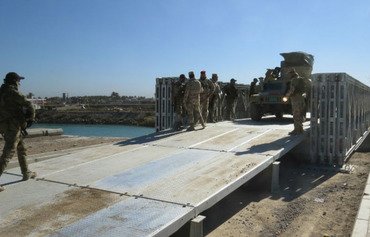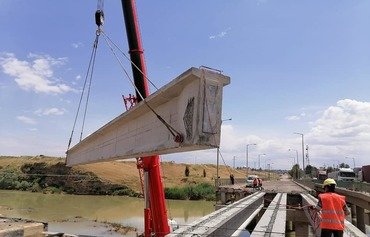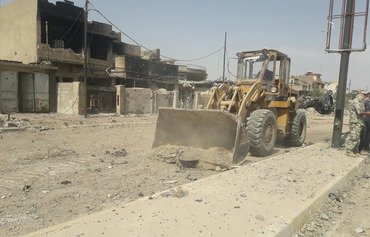The Iraqi government is rebuilding Mosul bridges damaged in the battles to oust the "Islamic State of Iraq and Syria" (ISIS) from the city as part of a rehabilitation plan backed by international funding, officials told Diyaruna.
Five main bridges over the Tigris link east and west Mosul, while smaller bridges span the Khosr river, which runs through eastern Mosul.
The plan is being implemented in two stages, with the first focused on repairing bridges that sustained the least damage and establishing temporary crossings. The second phase will address severely damaged bridges.
Repairs have been completed on the city's oldest bridge, al-Jisr al-Hadidi, Mosul municipality director Abdul Sattar al-Habboub told Diyaruna.
"It is hoped that the bridge will open to the public in mid-February," he said.
The Saad construction company, a subsidiary of the Ministry of Construction and Housing, completed the rehabilitation work over a period of five months with $2.5 million in funding from the World Bank, he said.
Temporary bridges
As part of the project's first stage, the ministry has erected two temporary bridges, one of which will be used in lieu of al-Hurriya bridge, al-Habboub said.
A temporary bridge also will replace the bridge that links al-Dhubbat neighbourhood in eastern Mosul with al-Dawasseh in the west, he said.
"The army, along with Mosul municipality, has opened two other temporary bridges," he said.
These will replace Abi Tammam al-Taie bridge and another bridge, Mosul's longest, which links al-Muhandiseen in eastern Mosul with al-Shifaa in the west.
The ministry is close to completing the Sayidati al-Jamilah bridge, a secondary crossing that connects al-Zuhour and al-Muthanna neighbourhoods, he added.
The new bridges are merely a temporary measure to ease traffic and help people traverse the city while the main bridges are being rehabilitated, he said.
The four main bridges that are still in need of repair will require "no less than a year to be rebuilt", al-Habboub said.
"A full report on the level of damages and estimated costs required to rebuild al-Hurriya and al-Rabeh bridges has been completed," he said, with reconstruction slated to begin soon, with help from a German loan.
"The total cost of rebuilding al-Hurriya bridge will be $25 million and al-Rabeh bridge $35 million," al-Habboub said.
Prioritising reconstruction
It will be important to prioritise the reconstruction, as there are 73 damaged bridges in the province, Ninawa provincial council security committee member Hassan Shabib al-Sabaawi told Diyaruna.
This is of utmost importance, he said, as bridges "directly impact people’s lives and help maintain the stability and flow of activity in cities".
"Temporary bridges in Mosul have managed to reduce traffic jams that increased after displaced families started to make their way back," he said, noting that these are no substitute for the permanent bridges, however.
Ninawa officials told Diyaruna they are optimistic that the upcoming donor conference in Kuwait will help with reconstruction efforts in their province.
"A significant amount of money needs to be spent on rebuilding bridges," said Ninawa provincial council services committee member Hosam Eddin al-Abbar. "We are relying on the Kuwait conference and in-kind donations offered by donor states."
"We have comprehensive reports on all infrastructure projects, including bridges, that were affected by terrorism, and all we need is international support to start work," he told Diyaruna.

![A Mosul municipality vehicle removes debris piled up near one of the city's main bridges. [Photo from the Mosul municipality directorate Facebook page]](/cnmi_di/images/2018/02/13/11266-Iraq-Mosul-bridges-600_384.jpg)






